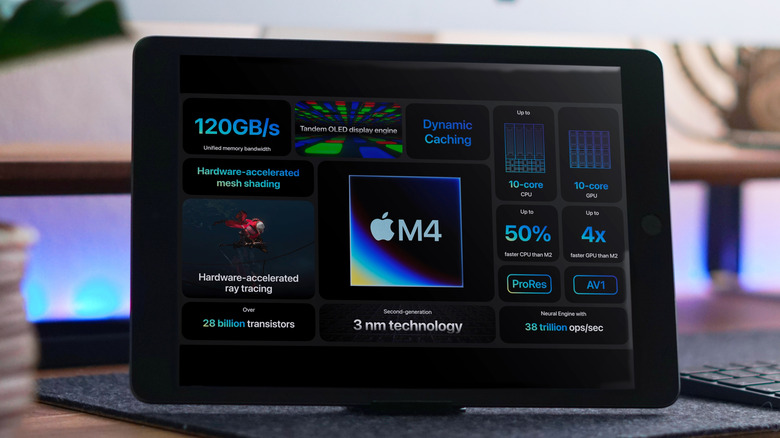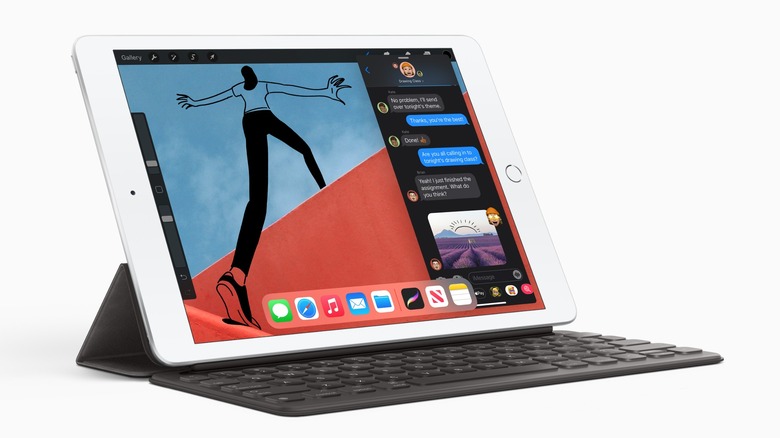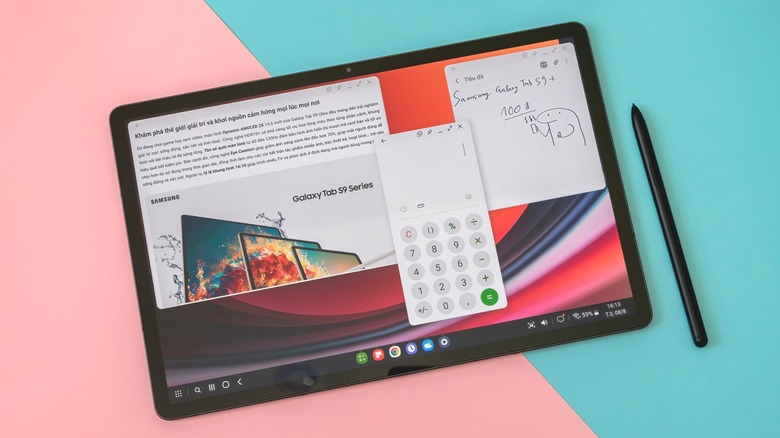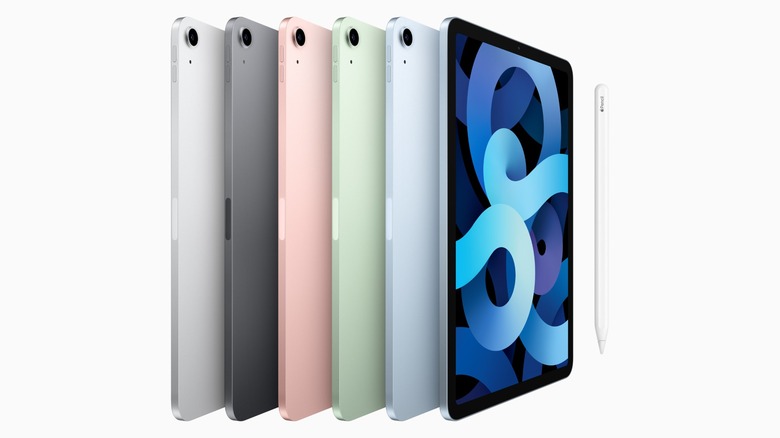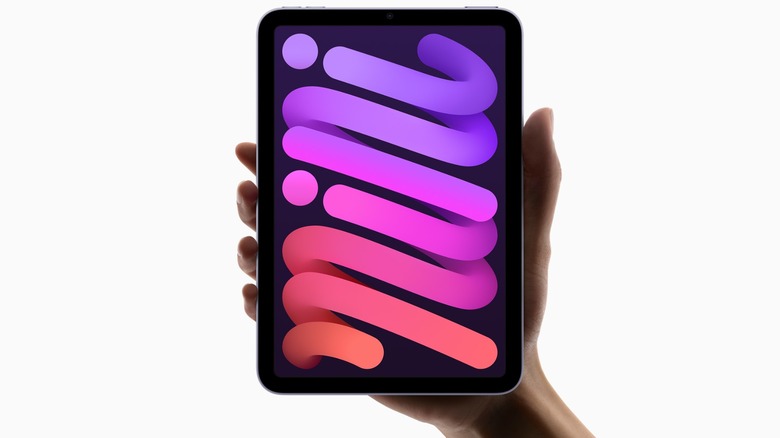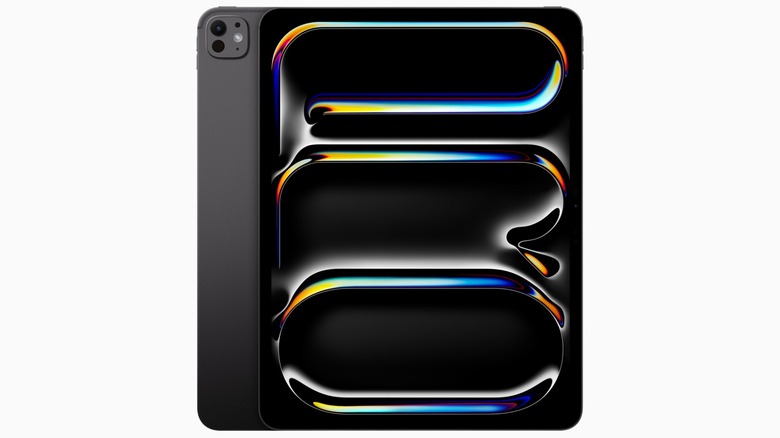The 10 Most Powerful Tablet Processors (Ranked By Geekbench)
We may receive a commission on purchases made from links.
Tablets have been around for a long time — probably longer than you think. From early '90s proto-tablets like Samsung's PenMaster and the infamous Apple Newton to Microsoft's innovative 2001 Tablet PC — a touch-input tablet that predated the Apple iPad by nearly a decade — and culminating in modern-day touchscreen powerhouses from Apple and Samsung, tablets have grown from simple pen-input devices to sleek slabs of metal and glass that can rival some of the best laptops out there in raw performance.
They may not be to everyone's taste, but it's hard to argue against how useful tablets can be. Just ask the many users worldwide behind the recent resurgence of the format, which saw an impressive year-on-year growth of 22.1% in the second quarter of 2024. Whether you want a tablet for reading ebooks, working on the go, increasing productivity at home, or even just playing video games on a larger screen than your smartphone, these devices can offer a lot — all thanks to how much power they pack under the hood these days.
And that power is what we'll be going over here with this list of the 10 most powerful processors in the Geekbench database, ranked by single-core scores.
10. Apple A12 Bionic
The 10th-most powerful tablet processor in Geekbench's ranking is Apple's venerable A12 Bionic, which first debuted in the iPhone Xs, Xs Max, and XR back in 2018. The A12 Bionic's six-core CPU and four-core GPU would later power the third-gen iPad Air and fifth-gen iPad mini, which debuted the year after. In 2020, Apple also brought it back for a third time for the eighth iteration of its entry-level iPad.
The A12 Bionic introduced Apple's next-generation Neural Engine, with a new eight-core chip giving it much better performance than its predecessor and opening up the possibility for apps to use real-time machine learning (ML) on A12 Bionic-equipped devices. The A12 Bionic also brought Apple's Neural Engine to iPads for the first time, as the A11 Bionic — the chip that introduced the Neural Engine — had not been present in any iPads. The seventh-gen base iPad had the A10 Fusion, while the second-gen iPad Air and fourth-gen iPad mini sported Apple's A8X and A8, respectively.
As far as raw performance (at least, as measured via Geekbench), the A12 Bionic offered a significant boost over the processors in older iPads. The processor's best numbers on the chart come in the third-gen iPad Air, with 1,325 points in the single-core test and 2,945 points in multi-core. Unexceptional numbers now, but a massive leap over the 442 and 949 points that the iPad Air 2's A8X scored.
9. Apple A12X/A12Z Bionic
The A12 Bionic was a notable leap over predecessors like the A11 Bionic, but Apple had more than just that one chip up its sleeves in 2018. Mere weeks after introducing the A12 Bionic in the iPhone Xs, the company introduced a souped-up version for the then-new 11- and 12.9-inch iPad Pro models called the A12X Bionic.
The A12X featured two more CPU cores and three more GPU cores, making for eight and seven cores, respectively. Apple touted impressive performance improvements from the new processor, boasting of 35% better single-core performance and an alleged 90% improvement in multi-threaded workloads — improvements that the company claimed made the A12X faster than 92% of mobile computers. The A12's upgraded Neural Engine was also present in the A12X, allowing the new iPad Pros to deliver better performance in Core ML than previous Apple devices.
Apple introduced another A12 variant in 2020, bringing a new lidar-equipped iPad Pro to the market with the A12Z Bionic under the hood. Apple didn't make any major performance claims about the A12Z Bionic, with the only notable change in the company's marketing materials being the introduction of an eight-core GPU in place of the old seven-core unit. Geekbench results bear this out, with the two processors performing nearly identically — that said, the A12Z Bionic is ever-so-slightly faster, with 1,333 single-core and 4,668 multi-core points (vs. the A12X's 1,329 and 4,635).
8. Google Tensor G2
Google's push into in-house SoCs began in 2021 with the Pixel 6 and Pixel 6 Pro, which saw the company introduce the AI- and ML-focused Google Tensor chip to the world. The company quickly followed it up with the Tensor G2, which powered 2022's Pixel 7 and Pixel 7 Pro, and would later resurface as the chip powering the Pixel Tablet.
Despite the Tensor chips broadly following in Apple's footsteps with the A-series SoCs, Google was never particularly focused on raw performance for its processors. The company has generally focused on camera and AI-assisted features, both of which the Tensor chips help accelerate and improve. This isn't to say that the Tensor G2 is weak, but it's not all that impressive in terms of raw power, either. The Tensor G2 in the Google Pixel Tablet scores 1,421 single-core and 3,614 multi-core points.
Does the Tensor G2's middling performance hobble the Pixel Tablet? Not necessarily, as our review shows — the Pixel Tablet does everything you need it to do, and does it well. But it says a lot about Google's priorities that its 2022 processor is only slightly faster in the single-core tests than an Apple processor from 2018 — and gets thoroughly destroyed in Geekbench by the SoCs that come after it in this list.
7. Apple A13 Bionic
A new year, a new Apple SoC. Hot on the heels of the A12 Bionic came the A13 Bionic, which debuted in 2019's dual-camera iPhone 11. At launch, Apple claimed that the A13 was the fastest smartphone chip to date, thanks to 20% higher CPU and GPU performance over the A12 Bionic. Apple also included a faster Neural Engine and all-new, built-in ML accelerators to push its devices' AI and ML capabilities even further.
Unlike previous Bionic SoCs, the A13 Bionic only ever made it to one Apple tablet. 2021 saw the debut of the ninth-generation iPad, with the A13 Bionic under the hood. Apple didn't mince words in its press release, stating that its new entry-level tablet was "up to three times faster than the best-selling Chromebook, and up to a whopping six times faster than the best-selling Android tablet." The iPad vs. Android tablet battle may not necessarily be clear-cut, but confident statements like that show that Apple's raw performance advantage has never been in question.
Geekbench scores bear it out, with only one Android processor ranking above the A13 Bionic. 1,736 points in Geekbench's single-core tests and 3,853 points in the multi-core test putting it ahead of all but the best Android tablet processors, even though it's five years old at this point. The ninth-gen iPad wasn't the last we saw of the A13 Bionic, though: Apple would later use it for its third-generation iPhone SE, which debuted in 2022.
6. Snapdragon 8 Gen 2
And now we come to the most powerful Android tablet processor in Geekbench's charts — at least until the Samsung Galaxy Tab S10's MediaTek SoC makes its official Geekbench debut. The Snapdragon 8 Gen 2 may not be the latest version of Qualcomm's flagship processor, but it flies the flag for Android tablets on the Geekbench charts, courtesy of Samsung's Galaxy Tab S9 tablets.
Qualcomm's Snapdragon 8 processors didn't get off to the greatest start, with the Snapdragon 8 Gen 1's much-publicized heat issues stopping it from performing significantly better than the Snapdragon 888 SoC it replaced. Qualcomm thankfully sorted that problem out with the Snapdragon 8+ Gen 1, before introducing the Snapdragon 8 Gen 2 in 2022 to firmly put its troubled start behind it. Qualcomm's big focus was on the Snapdragon 8 Gen 2's AI prowess, but the processor also offered notable performance and efficiency improvements: the company claimed 25% better GPU performance and 40% more CPU power efficiency.
Geekbench numbers for the Snapdragon 8 Gen 2 were a big improvement over its predecessor, especially in the Samsung Galaxy Tab S9. The Tab S9, which we rank as one of the best tablets for students thanks to its iPad Pro-rivaling qualities, also happens to have best performing implementation of Qualcomm's eight-core processor, with single- and multi-core scores of 2,028 and 5,423, respectively.
5. Apple A14 Bionic
Now we get into the current (at time of writing) top five tablet processors on Geekbench's charts. You likely won't be surprised to find that they're all Apple SoCs. In fifth place is the Apple A14 Bionic, which first debuted on the scene powering the 2020 iPhone 12s — from the iPhone 12 mini all the way up to the big boy iPhone 12 Pro Max — and the 2020 iPad Air.
The A14 Bionic was the first 5nm smartphone chip, with performance allegedly up to 50% faster than what Apple called "competing smartphone chips" — in other words, Qualcomm's offerings. This big performance boost came from a new six-core CPU design and a four-core GPU, making for 40% and 30% better performance, respectively. The A14 Bionic also had an upgraded Neural Engine with 16 cores, up from the eight cores Apple had introduced with the A12 Bionic — allowing for a claimed 80% increase in ML performance.
In 2022, Apple introduced the A14 Bionic to the entry-level iPad, updating the base tablet with a new 10.9-inch screen and the A14 Bionic's processing power. The new processor offered an alleged three times more performance than the seventh-gen iPad, putting the 10th-generation Apple iPad well ahead of the Android competition in pure performance. As far as Geekbench goes, the A14 Bionic's best tablet performance is 2,084 single-core and 5,005 multi-core points in the fourth-gen iPad Air.
4. Apple A15 Bionic
The A15 Bionic was the final Apple's A-series SoC to power any of the company's tablets. This chip, with its six-core CPU and five-core GPU, debuted as the processor powering Apple's iPhone 13 family of smartphones and the sixth-gen iPad mini in 2021.
In keeping with Apple's high-performance track record, the company claimed that the CPU and GPU were around 50% faster than Qualcomm's SoCs — not hard to believe, seeing as how it's still in the top five fastest smartphone processors despite being three years old as of late 2024. But the A15 Bionic was also a big upgrade for those already in the Apple ecosystem: The company claimed that the new A15 Bionic-powered Apple iPad mini had 40% and 80% better CPU and graphics performance, respectively, compared to the previous iPad Mini.
Combined with the ML improvements from the 16-core Neural Engine Apple had introduced with the A14 Bionic, the new iPad mini could chew through ML tasks at twice the speed. The A15 Bionic wasn't a huge leap in raw performance over the A14 Bionic otherwise, but its Geekbench scores of 2,121 and 5,364 in the single- and multi-core tests, respectively, are still excellent all the same.
3. Apple M1
For most of their life, Apple's iPad Pros had essentially shared processors with the company's smartphones, albeit in upgraded form, as with the A12X and A12Z Bionic from 2018. That all changed in 2021 when the company introduced the fifth-generation 12.9-inch iPad Pro and third-generation 11-inch iPad Pro. These closed the performance gap between Apple's flagship tablets and its laptops, sporting Apple's M1 chip which had debuted a year earlier in laptops like the Apple M1 MacBook Air.
The M1 was essentially an eight-core desktop- and laptop-grade processor, so it's no surprise that this new SoC offered major performance gains over the A12Z Bionic used in the previous-generation iPad Pro. Apple claimed 50% better CPU performance and 40% faster GPU performance, with extras such as a 16-core Neural Engine, an image signal processor (ISP), and high-performance memory thrown into the package. The end result was a tablet that on paper, could probably have replaced most laptops — though contemporary reviews of the iPad Pro felt that iPadOS held it back from doing that.
Restrictive OS aside, there was no argument about the new iPad Pros when it came to sheer performance. Geekbench scores for the Apple M1 inside the 12.9-inch iPad Pro came out to 2,305 and 8,357 in the single- and multi-core tests, with the improved single-core performance and two extra cores undoubtedly behind the huge multi-core boost over the A15 Bionic.
2. Apple M2
Despite having an unassailable lead at the top of the tablet hierarchy, Apple didn't rest on its laurels and launched the new Apple M2-powered iPad Pro in 2022. Size options remained the same as the previous generation — 11 inches and 12.9 inches — and had broadly the same features, with two major upgrades to try and entice M1 iPad Pro owners to upgrade.
The first, of course, was the new processor. The Apple M2 chip debuted in mid-2022 sporting an upgraded eight-core CPU combined with a much beefier 10-core GPU, up from the seven or eight-core GPUs available on the M1. The result was up to 15% more CPU performance and an impressive 35% uptick in graphics rendering. The extra grunt also helped the M2's Neural Engine perform 40% more operations than the M1, making the M2-powered iPad Pros even more capable of ML tasks than before. Geekbench scores climbed once again, with the 12.9-inch iPad Pro posting single- and multi-core scores of 2,572 and 9,777 points, respectively.
Despite the better performance, the biggest upgrade on the M2 iPad Pro was the introduction of Apple Pencil hover. Our Chris Davies tested the iPad Pro in 2022 and loved hover, which essentially allowed the tablet to detect and recognize the stylus from up to 12 millimeters away from the screen — allowing for pleasing UX details such as app icons and text fields enlarging before you touch them, as well as useful behaviors like brush and eraser previews in drawing apps.
1. Apple M4
The Apple M2 ruled the roost for a couple of years, with Apple keeping it in place through 2023 despite launching the 3nm M3 chips toward the end of that same year. Apple could have just kept making the iPad Pro M2 for the next handful of years without issue, such was the chipset's performance lead over Android rivals. It didn't, of course, and launched the Apple M4-powered iPad Pro in 2024.
Apple's iPad Pro M4 — which our Nadeem Sarwar reviewed and loved — launched in mid-2024 and was a big departure from the old iPad Pro. Bumped up fully to 11 and 13 inches, the iPad Pro also featured a new Ultra Retina XDR display, a new thin body — the company's thinnest ever, according to its marketing material — and the power of Apple's latest and greatest chipset. The Apple M4 has a 10-core CPU to match the 10-core GPU, with new hardware features and ML accelerators allowing for a claimed 1.5x CPU performance uptick over the M2 iPad Pro, all while using half of the power.
The upshot? Frankly impressive Geekbench scores of 3,668 single-core and 13,674 multi-core points, well ahead of even the M2 — at least, that's if you pony up for all 10 cores. Apple locks the M4's full performance behind a premium upgrade, with the most affordable iPad Pros only having a nine-core CPU. The software is also still a stumbling block, with our review finding that iPadOS can't quite offer the same productivity experience as macOS.
